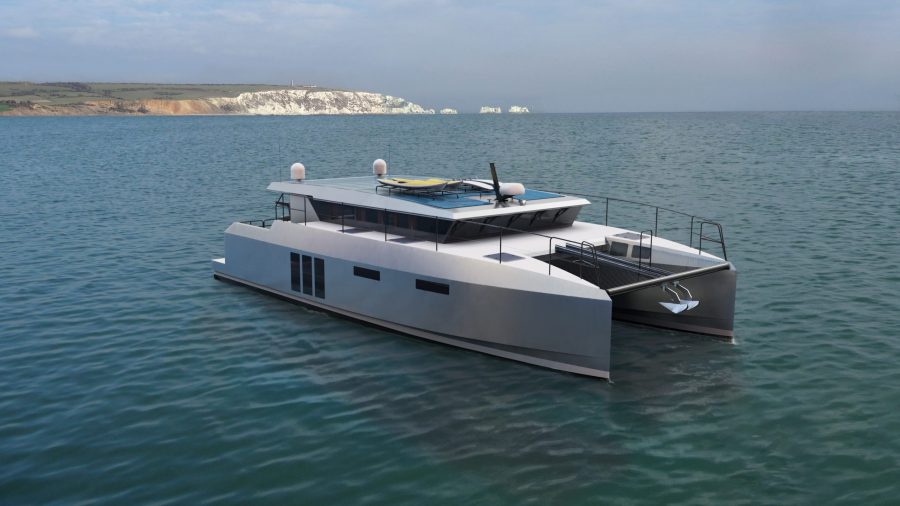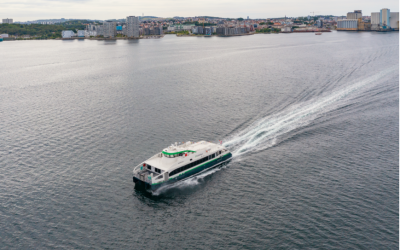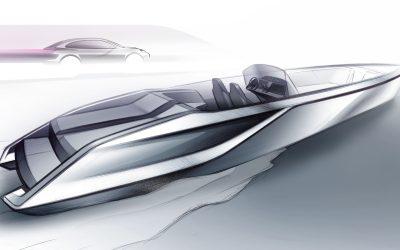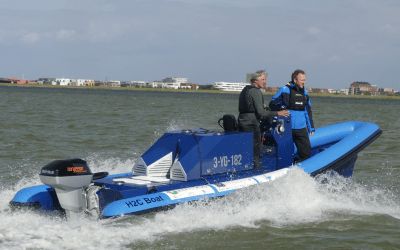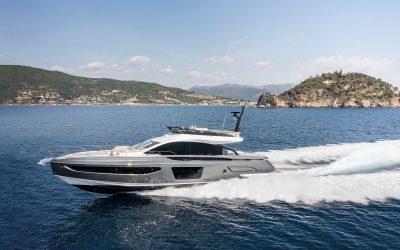Archipelago Yachts and Chartwell Marine’s catamaran concept makes a convincing case for an environmentally sound yet long-range leisure vessel, writes Stevie Knight
The new Archipelago zero.63 is a methanol fuelled, 18.3m conundrum, combining a number of elements that you wouldn’t necessarily expect in a single vessel. So, how – and why – have very disparate demands been convincingly blended?
Firstly, as Steve Weatherley, Archipelago Yachts MD, outlines: “It’s an expedition boat that can go anywhere and keep you safe in all weathers.” However, as well as taking on very long distances, it can also move at speed – and it’s equally suited to family day trips.
Secondly, the concept avoids ‘greenwashing’: it’s designed for real emissions savings rather than installing a token battery onboard. Thirdly, the design bridges two worlds, aiming to help both leisure and wind farm support vessels to find a commercially viable pathway toward emission-free, low-to-zero-carbon operation.
It sounds contradictory on first hearing, but digging into the details uncovers some pragmatic solutions to various issues. One interesting choice is that, like its cousin, the 14.5m Archipelago 47, it’s a catamaran. “Expedition boats of this type are typically designed as pure displacement monohulls,” says Weatherley. “That’s fantastic if you want to go across an ocean at 8-9knots, but they tend to lack the ability to move faster.
“I wanted to achieve a similar efficiency at displacement speeds, but also have the ability to get up on the plane. And I wanted something more flexible, with a wider variety of uses. A catamaran was the only real solution.”
Methanol selection
Weatherley was equally discerning about handling and seaworthiness in extremely rough conditions. However, when hunting around for a suitable boat in the leisure market, he drew a blank. So, he looked to the commercial sector and decided that Chartwell Marine’s range of CTVs met all of the demands. “They won me over with their aluminium design ability, and the fact that their boats are carrying technicians on the North Sea day after day,” he says.
After the initial Archipelago 47 design was unveiled last year, both teams started to explore alternative fuels. For Weatherley, the amount of ‘greenwashing’ he found in the leisure market was, he admits, “disturbing”. He points out: “Despite the marketing by some leisure boat companies, the figures often tell a different story. If you’re doing more than 3-4knots, you could find you’ve basically bought a diesel-fuelled boat – because that’s what’s powering the generators that charge the batteries”.
At the same time, Chartwell saw the opportunity for a broad range of vessels, winning a £320,000 (US$398,400) Innovate UK Smart grant to enable both teams – along with partners Boat Electrics & Electronics and Engineered Marine Systems – to develop Weatherley’s design. Methanol was chosen as the boat’s fuel as it has a higher energy density than batteries or hydrogen – and, unlike ammonia, methanol spills have little impact on marine life; storage can be achieved at standard atmospheric conditions; and biomass-produced versions could carry a near-zero carbon footprint.
The platform will be Archipelago Yachts’ new 18.3m x 8.5m beam expedition boat – but, since it’s a CTV crossover design, it is also able to demonstrate the system’s applicability to the offshore wind and commercial workboat sectors.
Vented chamber
The zero.63 is a semi-displacement catamaran with wave-piercing bows. The high wet deck allows for a large tunnel between the two demi-hulls: “It’s incredibly good offshore in challenging seas, with no slamming,” explains Weatherley, adding: “Thick aluminium plates on the boftom and skegs beneath the propellers allow the boat to dry out on a beach on a falling tide: a very appealing proposition for an explorer yacht”.
Despite the fine entry shape forward, the form picks up enough volume further back to house on each side a twin-bunk and double cabin (or office space) with enough head room to stand up. Laundry and workshop stores are located forward. Att of the cabins are two big engine spaces, and behind those are the propulsion systems.
Above, a large 8m x 6m superstructure holds a spacious main saloon, galley (with full-sized fridges) and helm in a flowing open plan arrangement, while the roof holds around 40m2 of photovoltaic cells. On the same level – although completely and carefully isolated – is a double-walled, monitored and vented chamber housing the AurigaGen marine fuel cells and the necessary reformers that turn the wet fuel into hydrogen.
These proton exchange membrane (PEM) fuel cells have an output of between 10-30kW per unit (depending on model), tucked inside a 1-1.3m x 0.6m x 0.4m box weighing 48-60kg. According to Auriga, these fuel cells enable real-time analysis and remote control via existing networks or 4G modem, and are designed to cope with a salt-laden atmosphere and sea fog.
Arguably, one of the most important characteristics for Weatherley and Chartwell is that the yacht concept is pretty much ‘plug’n’play’, so there is the ability to grow this element of the system by adding more fuel cells over time.
The same is true of the reformers: these RIX M2H2130 methanol-to-hydrogen generators provide the on-demand pure hydrogen required by the PEM fuel cells, using low-volatility methanol/de-ionised water as a feedstock. This gets around the need for hydrogen storage, which usually requires pressurised or cryogenic tanks, resulting in an unfeasibly large footprint. In fact, while the first installation will provide hotel loads at around 20kW, this container can house a system with a total output of 300kW: enough for all the consumers, including the propulsion, and it could potentially find a place for a modest battery as well.
Diesel-free
However, Weatherley and Chartwell won’t be utilising pure fuel cell power from the start, as current prices would make that type of boat prohibitively expensive. “It would be very difficult for us to make a boat commercially viable if it cost around £2-£2.5 million [US $3.15 million] just for the propulsion,” Weatherley explains. That said, he predicts that the onboard technologies will come down in price over the longer term – just not quite yet.
Despite the difficulties, this design isn’t falling back on diesel operation – but neither has the requirement for single-fuel methanol engines been easy to meet. While larger manufacturers offer a dual-fuel range, it’s still very rare at the smaller sizes. Still, a lot of searching turned up a four-stroke, six-cylinder engine by Enmar. As it’s part of the ScandiNAOS Group, the engine has been based on a robust Scania marine engine block. These aren’t dual-fuel engines: they run on MD97 methanol alone, with just a few percent additive to make up for the fuel’s requirement for higher temperature ignition, so no extra tank is required for diesel, Weatherley underlines.
Fed by double-walled, vented and monitored piping from the methanol tanks, these engines exhibit a fairly steady efficiency of 41-45% all the way between 1,000-1,900rpm, with no SOx, low NOx and close to zero particulate emissions, and easily reaching IMO Tier III compliance without atter-treatment, saving space.
However, one option is to run the engines as gensets at a steady, peak-efficiency 1,400rpm, and to commit to an electric distribution. While there’s nothing quite as efficient as a straight shatt from the engine, this would make the slotting in of more fuel cells or other power generators somewhat easier – though again, “it partially depends on how much it puts up the price”, says Weatherley. This, too, is a practical question that promises to return an interesting set of answers for the project.
“Safe and practical”
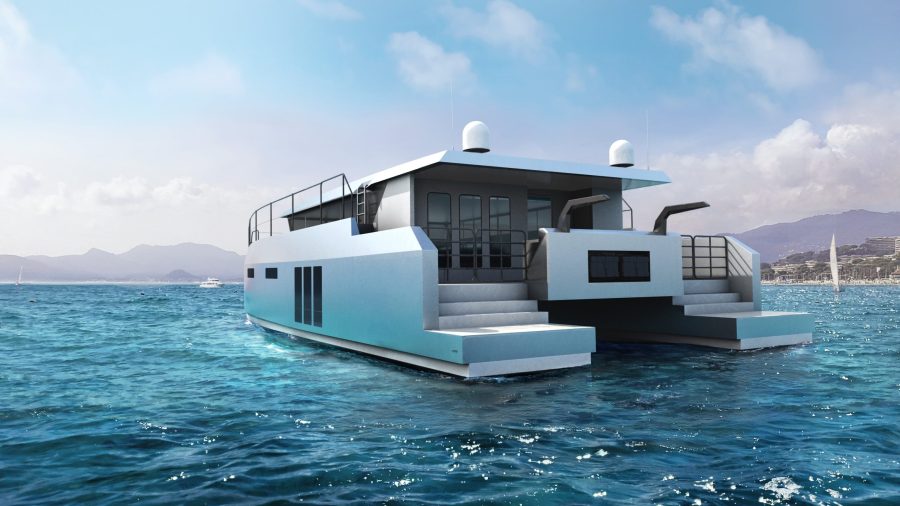
The vessel’s roof holds around 40m2 of photovoltaic cells
The installed power (whether methanol combustion or fuel cells) is scaled to give the boat a top speed of around 18-19knots, and possibly a tad over. That means, while it can take on truly ‘expedition-length’ journeys – aiming for a range of 2,000nm – it also allows bringing family and friends along on shorter trips. The other important element is that this will also grant the regulatory bodies the chance to evaluate this kind of methanol-fuelled design. “Due to lack of familiarity, regulators will tend to err on the side of caution,” says Weatherley. “So, one of the challenges will be demonstrating that what we are building is safe and practical.”
As Chartwell Marine’s director Andy Page explains, the idea is “to take methanol forward in a meaningful way and cut through some of the challenges we’ve seen in the development of alternative fuels”. While Page admits that there are still hurdles to overcome, including refuelling infrastructure, weight and efficiency, he sees the project as able to “create a proof-ofconcept methanol vessel that will be cost-effective, well-engineered and hydrodynamically optimised for deployment worldwide”.
